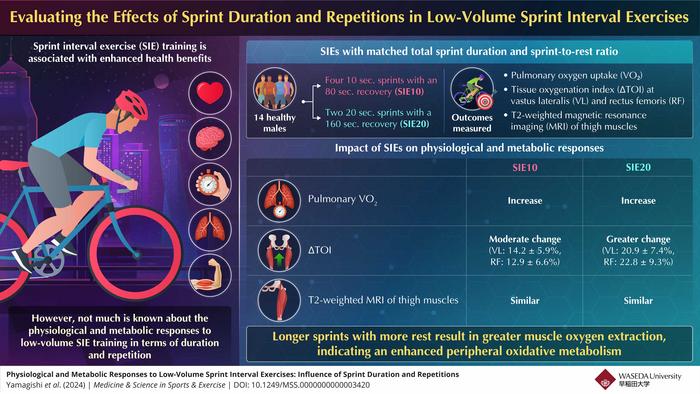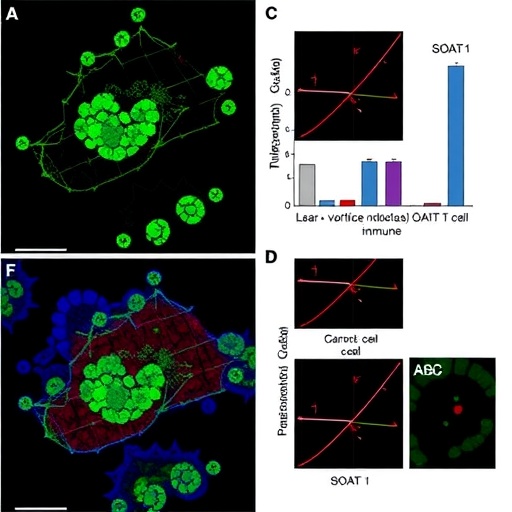Physical activities like jogging, walking, cycling, and sprinting are activities known to engage the musculoskeletal system and result in the utilization of energy. Sprint interval training (SIT) is a type of sprinting exercise that involves cycles of intense exercise followed by a short duration of rest. How the durations of exercise and rest are structured can affect the impact of SIT on physiological responses. In recent years, the field of sports physiology has witnessed increased interest in optimizing SIT protocols. This surge can enhance the recognition of SIT’s efficacy in improving athletic performance and overall well-being, highlighting its versatility as a tool for promoting health and fitness.

Credit: Takaki Yamagishi from Japan Institute of Sports Sciences and Waseda University
Physical activities like jogging, walking, cycling, and sprinting are activities known to engage the musculoskeletal system and result in the utilization of energy. Sprint interval training (SIT) is a type of sprinting exercise that involves cycles of intense exercise followed by a short duration of rest. How the durations of exercise and rest are structured can affect the impact of SIT on physiological responses. In recent years, the field of sports physiology has witnessed increased interest in optimizing SIT protocols. This surge can enhance the recognition of SIT’s efficacy in improving athletic performance and overall well-being, highlighting its versatility as a tool for promoting health and fitness.
Now, in an effort to highlight the benefits of SIT, a team of researchers from Japan, comprising Dr. Takaki Yamagishi from the Department of Sport Science and Research, Japan Institute of Sports Sciences and Human Performance Laboratory at the Comprehensive Research Organization at Waseda University, and Professor Yasuo Kawakami who directs the Human Performance Lab and is from the Faculty of Sport Sciences, Waseda University, conducted SIT experiments with healthy human volunteers in a recent study. This study was published online in Medicine & Science in Sports & Exercise journal on March 7, 2024.
Explaining the motivation behind their research work, Yamagishi says, “Establishing a minimum dose of exercise training to bring about training benefits, such as aerobic fitness, has been one of my main research interests. Due to the support from Prof. Kawakami and other co-authors, along with the collaboration with Waseda University, this unique research work using a multifaceted approach was possible.”
The team of researchers matched two different sprint interval exercises (SIE) for the total duration of sprint and sprint-to-rest ratio. They analyzed the influence of SIE on physiological and metabolic responses by examining pulmonary oxygen uptake (V̇O2) levels and changes in tissue oxygenation index (∆TOI) in thigh muscles. Additionally, they utilized the T2-weighted magnetic resonance imaging (MRI) technique to assess the activation of thigh muscles.
The researchers highlight that SIE20, comprising of two 20-second sprints with 160-second recovery, outperformed SIE10, which involved four 10-second sprints with 80-second recovery. While both the SIE protocols significantly increased whole-body and peripheral oxidative metabolism and the activation of the major thigh muscles, as indicated by the increases in V̇O2 levels, ∆TOI and MRI T2 values, respectively, greater peripheral oxidative metabolism was achieved with SIE20. They also observed that successive sprint repetitions in SIE10 did not correlate with greater oxidative metabolism.
Elaborating on the real-life applications and impact of the present research, Yamagishi says, “In today’s fast-moving world, lack of time is a major hindrance to regular physical activity. However, the exercise modalities employed in our study require less than 15 minutes to complete and provide considerable health benefits.”
In summary, the findings from this study can address important research gaps in SIT, such as the effects of minimum sprint duration and repetitions on aerobic and metabolic responses in humans. In-depth studies on low-volume SIT have the potential to improve training programs and exercise regimens. Sharing his concluding thoughts, Yamagishi says, “Exercise guidelines proposed by major organizations such as the American College of Sports Medicine are updated every 5 to 10 years, and we are hopeful that our study can be a part of it. Future studies on SIE can build on our findings to establish the dose-response relationship between exercise volume or intensity and the degree of training adaptations.”
***
Reference
Authors: Takaki Yamagishi1,2, Soya Iwata3, Shun Otsuka4, Hoshizora Ichinose5,6, and Yasuo Kawakami7,2
Title of original paper: Physiological and Metabolic Responses to Low-Volume Sprint Interval Exercises: Influence of Sprint Duration and Repetitions
Journal: Medicine & Science in Sports & Exercise
DOI: https://doi.org/10.1249/mss.0000000000003420
Affiliations:
1Department of Sport Science and Research, Japan Institute of Sports Sciences, Tokyo, Japan
2Human Performance Laboratory, Comprehensive Research Organization of Waseda University, Tokyo, Japan
3Division of Vehicle Development, Mazda Motor Corporation, Hiroshima, Japan
4Department of Anatomy, Aichi Medical University, Aichi, Japan
5Graduate School of Sport Sciences, Waseda University, Saitama, Japan
6Division of Anatomical Science, Department of Functional Morphology, Nihon University, School of Medicine, Tokyo, Japan
7Faculty of Sport Sciences, Waseda University, Saitama, Japan
About Waseda University
Located in the heart of Tokyo, Waseda University is a leading private research university that has long been dedicated to academic excellence, innovative research, and civic engagement at both the local and global levels since 1882. The University has produced many changemakers in its history, including nine prime ministers and many leaders in business, science and technology, literature, sports, and film. Waseda has strong collaborations with overseas research institutions and is committed to advancing cutting-edge research and developing leaders who can contribute to the resolution of complex, global social issues. The University has set a target of achieving a zero-carbon campus by 2032, in line with the Sustainable Development Goals (SDGs) adopted by the United Nations in 2015.
To learn more about Waseda University, visit https://www.waseda.jp/top/en
About Dr. Takaki Yamagishi
Dr. Takaki Yamagishi is a researcher at the Department of Sport Science and Research, Japan Institute of Sports Sciences and the Human Performance Laboratory at the Comprehensive Research Organization at Waseda University. Dr. Yamagishi obtained his Ph.D. from Abertay University, Scotland in 2016. His research interests include sports science, training adaptations, exercise performance, and sport physiology. He has published 18 papers that have been cited 130+ times. His present research work involves the development of alternative and innovative methods for the determination of endurance performance in high-performance athletes. He is a member of Japan Society of Training Science for Exercise and Sport, European College of Sport Science, and Japanese Society of Biomechanics.
Journal
Medicine & Science in Sports & Exercise
DOI
10.1249/mss.0000000000003420
Method of Research
Experimental study
Subject of Research
People
Article Title
Physiological and Metabolic Responses to Low-Volume Sprint Interval Exercises: Influence of Sprint Duration and Repetitions
Article Publication Date
7-Mar-2024
COI Statement
This study was funded by Grant-in-Aid for Early-Career Scientists (JSPS KAKENHI Grant number: 19K19990), Japan Society for the Promotion of Science. There were no professional relationships with companies or manufacturers who will benefit from the results of the current study.




